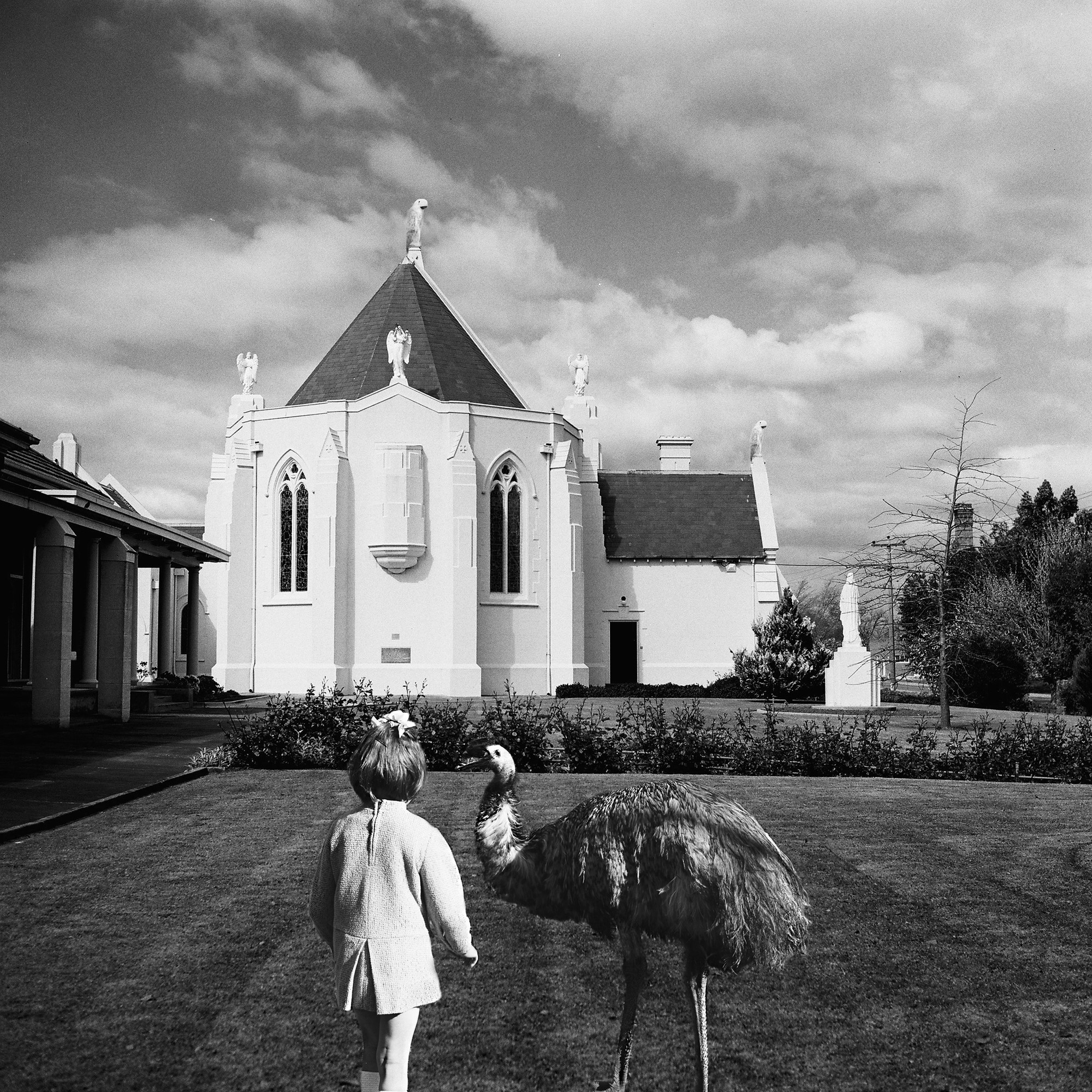Hayley Millar Baker’s “There we were all in one place”
By Johanna Bear

HAYLEY MILLAR BAKER, _Untitled 2 (I
Cross-cultural photographic artist Hayley Millar Baker (Gunditjmara) tells stories, both real and imagined, that revel in the slipperiness of memory and time. Her early-career survey “There we were all in one place” at UTS Gallery, University of Technology Sydney, brought together five series of black-and-white digital collages (2016–2019) that conjure surreal topographies, ghostly interiors, and dystopic suburbia. Developed through extensive research, familial knowledge-sharing, production, and editing, each layers the artist’s photographs with archival imagery in arresting compositions of personal and cultural remembrance.
The voices of Millar Baker’s Gunditjmara family and ancestors permeate her works, and affirm the richness and strength of over 60,000 years of Australian Aboriginal culture. Each work honors Indigenous understandings of time as cyclical by intersplicing images from different eras into scenes that exist in a state of timelessness. It is up to viewers whether these are speculative reimaginings of what has been, or what is to come. In this way they acknowledge that the horror of Australia’s colonization is not contained or discrete, but reverberates today and into the future.
Seven small frames from Millar Baker’s earliest series, I’m the Captain Now (2016), hang to the entrance’s right. The basis of the works are photographs taken by her grandfather—gifted among a box of slides and negatives that inspired her shift from painting to photographic collage. Millar Baker’s mother and aunt appear prim and duteous in their Sunday best, enacting their White father’s vision of an ideal 1960s childhood in suburban Victoria. The artist’s reimagining inserts visual cues of their Aboriginal culture absent from the originals. They now fish with kooyang (short-finned eel) traps, play near a “You are on sacred Aboriginal land” sign, and carry woven dilly bags on outings. At church they worship a statue of Bunjil—the venerated eaglehawk ancestor of Gunditjmara and neighboring southeast Australian nations. By resituating her family in a country that celebrates this culture, Millar Baker both honors Aboriginal resilience and laments the ease of cultural erasure in Australia.

Installation view of HAYLEY MILLAR BAKER
Layers of time converge in the atmospheric Toongkateeyt (Tomorrow) (2017) series. Over a meter high, these works coalesce up to three hundred of Millar Baker’s digital and medium-format photographs of Gunditjmara Country, her ancestral homelands, and Wathaurong Country, where she grew up. They envelop viewers in shimmering landscapes of intricate shadows. Minute details flicker and sharpen the longer one succumbs to their depths. Merging individual photographs of rocks, animals, natural scenery, and man-made architecture from these sites, Millar Baker builds a singular place for the rich matrix of memory and experience embedded in Country over five generations. “A single experience isn’t a single experience,” says Millar Baker, “it can be made into a whole galaxy.” In the particularly striking Even if the race is fated to disappear 2 (Peeneeyt Meerreeng / Before, Now, Tomorrow), gnarled rocks and branches loom forward, streams curve around central grassy islands, and hazy clouds rise from distant trees. Tiny koalas, emus, and a soaring Bunjil ripple the surface of what at first seems a perfectly mirrored landscape. Each frame enshrines the multitudes of identities, cultures, memories, and perspectives held within these sites.

HAYLEY MILLAR BAKER, Untitled (The circumstances are that a whale had come on shore) from A Series of Unwarranted Events, 2018, inkjet print on cotton rag, 67 × 67cm. Courtesy the artist and Vivien Anderson Gallery, Melbourne.
Gunditjmara Country again appears in the disquieting landscapes of A Series of Unwarranted Events (2018). Hundreds of Millar Baker’s photographs are shaped into seamless homages to survivors of the frontier wars, especially the Eumeralla Wars in the 1830s to ’60s when Gunditjmara people were massacred fighting colonial possession of their land. The artist’s works become monuments to these events—from the arsenic-laced flour traps set by colonists in Untitled (So he mixed arsenic with half the flour and a raging thirst was created) to the beached whale on a ghostly, rocky shoreline in Untitled (The circumstances are that a whale had come to shore), which escalated tensions between Gunditjmara and British whalers, leading to the earliest recorded Victorian massacre of Aboriginal people. These narratives are often excluded from Australia’s official records and education curriculums, but Millar Baker speaks their truth today.
“There we were all in one place” had the intimacy of a family gathering. These moments of union encouraged one to reflect on genealogy and place, and understand them as repositories of both trauma and strength. Millar Baker’s works turn viewers into witnesses, compelling reflection on stories that entwine the personal with the political to generate space for healing, understanding, and empathy.
Hayley Millar Baker’s “There we were all in one place” is on view at UTS Gallery, Gadigal Country, Sydney, until June 4, 2021.
To read more of ArtAsiaPacific’s articles, visit our Digital Library.







